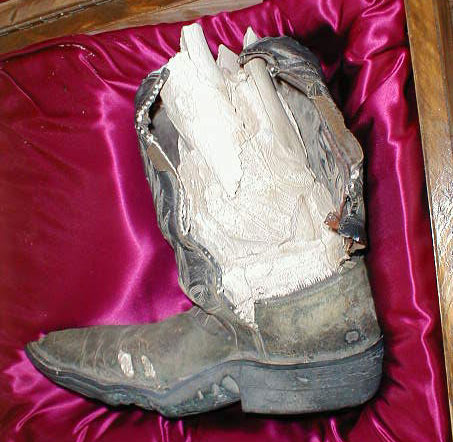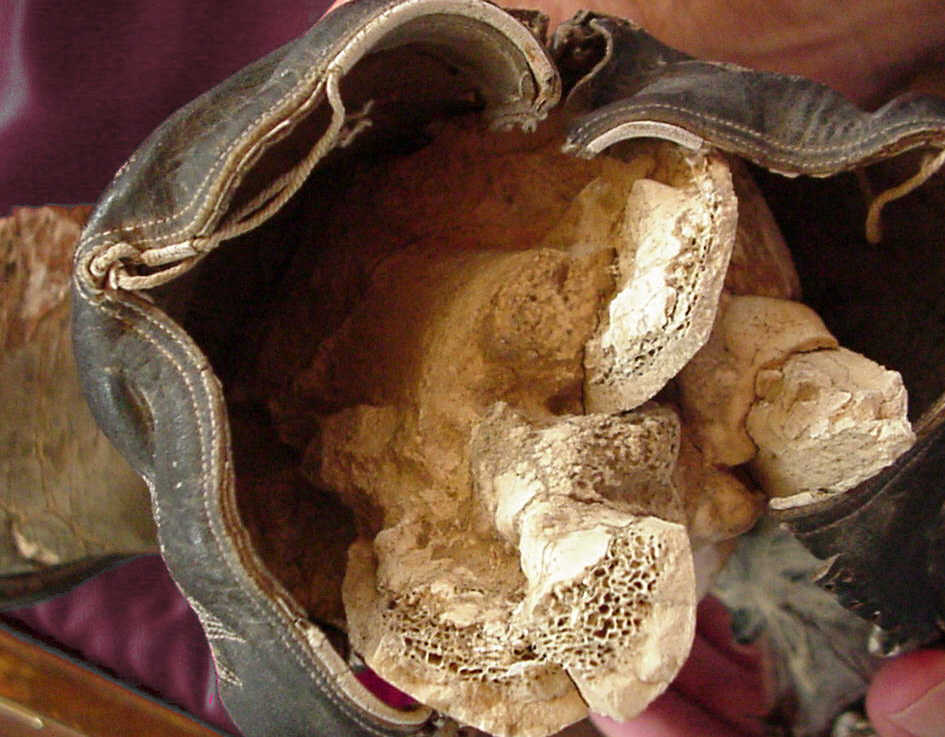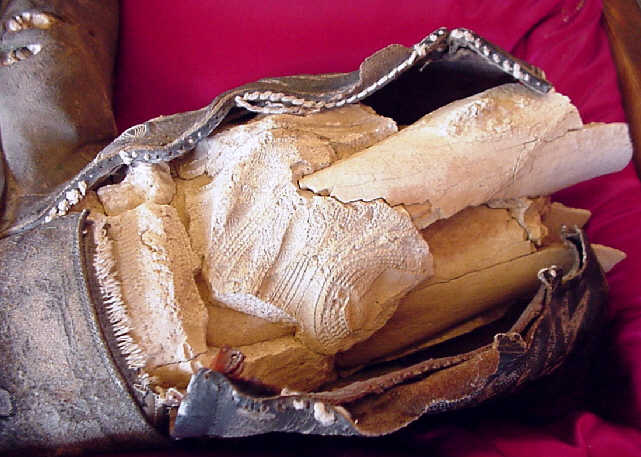
| E-mail author | Paluxy Home page |

| Fig. 1. Boot with alleged fossilized leg |
In June 2006 Baugh removed the original "Limestone Cowboy" article from his website, although a single paragraph in the "archives" still promotes it. He also did not display the boot among other allegedly anomalous artifacts discussed during his June, 2006 seminar at his Creation Evidence museum in Glen Rose, Texas.
Although I have not been allowed to examine the boot in person, the above considerations alone invite strong skepticism of Baugh's claims. Whenever extraordinary claims are made, the burden is on the claimants to demonstrate their veracity, not on skeptics to prove them wrong. In view of this, as well as Baugh's long history of sensational and unfounded claims, a high degree of skepticism about this "limestone cowboy" boot is warranted.
1. The author evidently believes the earth is only thousands of years
old.
2. The boot is modern looking and acknowledged to have been manufactured
about 1950.
3. The boot was not even claimed to have been embedded in any ancient
rock formation.
At any rate, Keohane makes no further mention of the "40 million years." Nor does his site, Baugh's, or Patton's mention whether other remains of the cowboy were found near the boot.
Evidently Baugh acquired the boot during the late 1990's and added it to his collection of other alleged anti-evolutionary objects in his "Creation Evidence Museum" in Glen Rose, Texas. Baugh and his former partner Don Patton assert that the boot contains "fossilized" bone and flesh, but other than the unpublished and unverified C.T. scans, have not provided any rigorous evidence to support these claims. Indeed, if the claims are true, one wonders why they have not demonstrated this by conducting and publishing tests on the composition and geochemical properties of the bones and surrounding matrix. The situation is reminiscent of Patton's claims regarding the "Moab Man" or "Malachite Man" skeleton, which he asserts are thoroughly fossilized, but which this author and others found to be unfossilized, essentially modern bones with little or no mineral replacement.
In any case, Baugh's website essay also stated that only the contents of the boot are fossilized, not the boot itself, "demonstrating that some materials fossilize more readily than others." However, it seems very implausible that bones and flesh would be "petrified" while the boot, reportedly made of mostly of leather (another organic material), remained virtually unaltered. In Fig. 3 one can even see the stiching threads, which also look completely modern and unaltered. These inconsistencies alone would warrant that reliable independent investigators be allowed to closely examine the contents of the boot to evaluate Baugh's claims.

| Fig. 2. Bones in the boot, viewed from top. |

| Fig. 3. Back view of boot and bones. |
Although Baugh and Patton have repeatedly referred to the bones in the boot as "fossilized," they have presented no evidence that they are anything but modern bones surrounded by hardened modern sediment. One sees no indication in the bones of foreign mineral replacement, or even any infilling of the air spaces in the inner "spongy-bone" portions of the bones (see Fig. 2). If these are "fossilized" bones, it certainly is not apparent in the photographs.
Furthermore, the material around the bones does not appear to have the shape of a human leg. The bulk of the matrix appears to take the shape of the boot itself, and its surface seems to record the contours and texture of the inside of the boot. Thus, rather than representing fossilized flesh, it seems more likely that the matrix around the bones is simply a natural cast composed of whatever sediment (probably a limy mud) filled the boot after the flesh rotted away. The mud probably became fairly hard as it dried (which is not unusual) but is unlikely to be true limestone, let alone petrified or "fossilized" flesh.
In fact, the boot advocates have not even demonstrated that the bones in question are human. The bones appear to be compatible with a large mammal, but seem surprising large in relation to the size of the boot. Without more thorough documentation, it is diffult to say what creature they belong to. For all we know, someone could have stuck some cow bones in a muddy boot. On the other hand, if the bones are really human as Baugh maintains, then he should report the remains to the authorities, since they could relate to a missing person or criminal case.
As reported in the North Texas Skeptics newsletter , in 1997 Don Patton displayed the boot at a meeting of a local creationism group called MIOS (Metroplex Institute of Origins Studies). There he promoted it as evidence of rapid fossilization, which he also does on his web site (Patton, 2006). On the same page Patton shows a photo of what appears to be a tattered, dirty dress hat, with no explanation other than a caption which reads, "Is this a cave man's hard hat?" My reply would be, "I don't know Don--maybe it belonged to the cowboy."

| Fig. 4. Unexplained hat on Patton's web site |
Baugh's web site article (since removed) stated that the "bones of the partial leg and foot within the boot were revealed by an elaborate set of C.T. Scans performed at Harris Methodist Hospital in Bedford, Texas on July 24, 1997. The Radiologic Technician was Evelyn Americus, AART. A complete set of these scans remains with the boot at the Creation Evidence Museum in Glen Rose, Texas." However, Baugh did not indicate exactly what these images show. One might ask, for example, if they actually show foot bones why such images are not shown on Baugh's site (or any other, to my knowlege). My attempts to locate Evelyn Americus have so far been unsuccessful.
Although Baugh and Patton's "limestone cowboy" claims have been repeated by a number of minor, tabloid-level websites, to my knowledge no major scientific or creationist organization has endorsed them.
Unless more rigorous evidence is provided by Baugh or
other "limestone cowboy boot" advocates, their claims that the boot
contains a fossilized leg must be regarded as dubious at best. It
appears more likely that the boot contains unfossilized bones
surrounded by whatever sediment filled and hardened in the boot
void after the flesh decayed away--providing no evidence against
evolution, nor even rapid fossilization.
Keohane, Steve, 2006, Bible Probe website promoting the "Limestone Cowboy" boot:
Patton, Don, 2005, 2006, Website (Dave Rudd, Webmaster) discussing the cowboy boot: